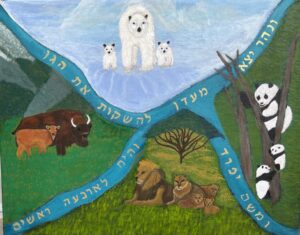Ben Bag Bag famously declared, “Turn it, turn it for everything is in it.” I’m sure this first century sage never imagined that a twenty-first century rabbi would turn over the words of Shir HaShirim to reveal a paean to deep ecology and an antidote to the perils of climate change.
Rabbi Ellen Bernstein, zichrona livracha, who passed away two months ago at the age of 70, had just published a new translation of Shir HaShirim entitled Toward a Holy Ecology: Reading the Song of Songs in the Age of Climate Crisis.
Rabbi Bernstein was considered the “Mother” of the Jewish Ecology Movement. Her earlier books, including her PassoverPassover is a major Jewish holiday that commemorates the Jewish people's liberation from slavery and Exodus from Egypt. Its Hebrew name is Pesakh. Its name derives from the tenth plague, in which God "passed over" the homes of the Jewish firstborn, slaying only the Egyptian firstborn. Passover is celebrated for a week, and many diaspora Jews celebrate for eight days. The holiday begins at home at a seder meal and ritual the first (and sometimes second) night. Jews tell the story of the Exodus using a text called the haggadah, and eat specific food (matzah, maror, haroset, etc). HaggadahLit. "Telling.” The haggadah is the book used at the seder table on Passover to tell the story of the Exodus, the central commandment of the holiday. It is rich in song, prayer, and legend. There are many different version of the Haggadah produced throughout Jewish history., The Promise of the Land, poetically articulate the connection between humans and all of Creation.
The Song of Songs has traditionally been interpreted as an allegory of the love between G-d and IsraelLit. ''the one who struggles with God.'' Israel means many things. It is first used with reference to Jacob, whose name is changed to Israel (Genesis 32:29), the one who struggles with God. Jacob's children, the Jewish people, become B'nai Israel, the children of Israel. The name also refers to the land of Israel and the State of Israel. or between a human couple. Bernstein reinterprets the text to bring out its nature imagery and themes. She calls it “a meditation on our relationship with nature animated by love.” The inter-relationship between the lovers, the land and its creatures leads her to a vision of interdependence and wholeness that is an expression of the oneness and holiness of G-d.

How does she arrive there?
Bernstein points out that more than half the verses of the Song convey images of nature and the land of Israel. The lovers compare themselves to plants, animals, minerals, mountains and cities. They inhabit a garden reminiscent of the Garden of Eden.
The Song also reflects the natural cycles of time. It begins at the end of Summer with reference to the woman’s sun-darkened skin, proceeds through the rainy Winter, to the flowering of Spring, to the blissful days of Summer.
Nature and seasonal imagery predominate in this familiar passage from Chapter 2:
GetA writ of divorce. Traditionally, only a man can grant his wife a get. Liberal Jews have amended this tradition, making divorce more egalitarian. up, my friend, my beauty,
And come away.
For now the winter is past,
The rain is over and gone.
The scarlet blossoms have appeared in the land,
The time of the songbird has come,
The voice of the turtledove is heard in our land.
The green figs form on the fig tree,
The flowering vines give off their fragrance.
Get up my friend, my beauty,
And come away.
Bernstein’s translation heightens the nature imagery in the Song. She often chooses more literal meanings for the Hebrew rather than the widely used Jewish Publication Society version.
For example, in Chapter 7 JPS translates ha-sadeh as “into the open.” Bernstein, however, keeps the literal meaning of “into the field.” Where the JPS version says “our couch,” Bernstein writes “our leafy bed.” Her translations are all legitimate definitions of the Hebrew and deepen the nature imagery of the text.
Another aspect of Rabbi Bernstein’s translation is her choice of relationship vocabulary to emphasize the inter-relational aspects of the people and the land. For example, “O maidens of JerusalemLit. City of peace From the time of David to the Roman destruction, Jerusalem was the capital of Israel and the spiritual and governmental center of the Jewish people. During the long exile, Jews longed to return to Jerusalem and wrote poems, prayers, and songs about the beloved city. In 1967, with the capture of the Old City, Jerusalem was reunited, becoming "the eternal capital of Israel." Still, the longing for peace is unfulfilled.” in the JPS version becomes “O daughters of Jerusalem” in Bernstein’s text.
When the male in the JPS translation describes his lover as “My own,” Bernstein translates achoti as “My sister,” the more literal meaning. In Chapter 8, the JPS version says “A lover is listening.” Bernstein writes, “Our friends [chaverim] are listening,” emphasizing a wider relationship.
Through her translation and her commentary, Rabbi Bernstein points us toward, in her words, the “interbeing of all life.” Nature, humans, flora and fauna form one wholeness that is a manifestation of Divinity.
For Bernstein, the ShemaThe most central prayer in Jewish liturgy, the Shema states: "Hear O Israel, the Lord Our God, the Lord is One." These words are written inside mezuzot and t'fillin. It is traditionally said during all major services and when waking and going to sleep., our central declaration of faith, is not limited to the theological conception that there is only “One G-d.” Rather she understands the Oneness of G-d in the broadest possible way as, in her words, “a testimony to the inter-relatedness of all being.” She continues, “If G-d is one, that oneness must encompass the whole of Creation. Then we and all creatures of the world are related—kin—bound together in oneness.”
Finally, Bernstein notes that two individuals bookend Shir HaShirim: King Solomon and the Shulamite woman. The Hebrew root of both names is shin-lamed-mem, the root of “Shalom” and also “Shalem”, meaning Peace and Wholeness. These two transcendental values undergird the Song of Songs.
In the conclusion to her commentary, Bernstein writes, “The Song’s deeply ecological perspective and its ability to evoke the sacred through a vocabulary of wholeness offers a vitally important message for our age.” As you read this poem on PesachPassover is a major Jewish holiday that commemorates the Jewish people's liberation from slavery and Exodus from Egypt. Its Hebrew name is Pesakh. Its name derives from the tenth plague, in which God "passed over" the homes of the Jewish firstborn, slaying only the Egyptian firstborn. Passover is celebrated for a week, and many diaspora Jews celebrate for eight days. The holiday begins at home at a seder meal and ritual the first (and sometimes second) night. Jews tell the story of the Exodus using a text called the haggadah, and eat specific food (matzah, maror, haroset, etc)., experience it as Rabbi Bernstein does in her provocative and very relevant Toward a Holy Ecology.
Art: Genesis 2:10 by Sue Gurland
Sue Gurland is both an artist and the creator of Moving Through the Tree of Life






